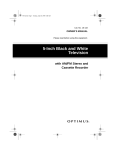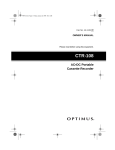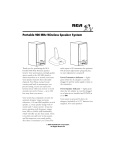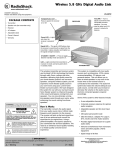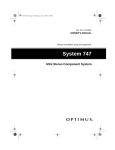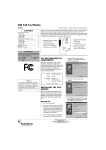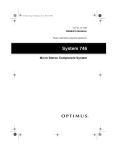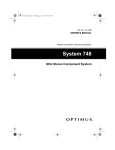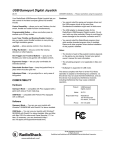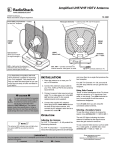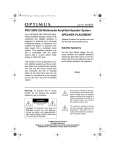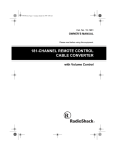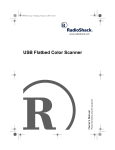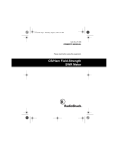Download Optimus 12-1610 User's Manual
Transcript
12-1610.fm Page 1 Friday, July 9, 1999 10:10 AM Cat. No. 12-1610 OWNER’S MANUAL Please read before using this equipment. CR-307 AM/FM•Weather Clock Radio 12-1610.fm Page 2 Friday, July 9, 1999 10:10 AM FEATURES Your Optimus CR-307 AM/FM •Weather Clock Radio has all the features of an alarm clock and a quality AM/FM radio. It is also designed to receive National Weather Service broadcasts, which provide information about weather conditions and forecasts 24 hours a day. Its features include: Push Button Operation — makes the clock easy to use. Sleep Timer — plays the radio for up to 2 hours before it automatically turns off, so you can listen as you fall asleep. Snooze — temporarily turns off the alarm for about 9 minutes, so you can get a few extra minutes of sleep. Red LED Display with Brightness Control — makes the clock easy to read. Built-In Speaker — lets you listen to the radio without using headphones. Battery Sentinel — shows when you need to install or replace the backup battery. Weather Alert — sounds a built-in siren when it detects a weather alert broadcast. Optional Siren Lock — allows you to set the alert siren to continue sounding until you turn it off. Siren Test Button — lets you check the alert siren circuitry and hear what the siren sounds like. Two Antennas — give you the option of using the line cord or the telescoping rod antenna for the best weather station reception. Seven Weather Channels — let you choose the frequency that gives you the best reception for regional weather information. PLL Synthesized Tuning — ensures tuning accuracy. Battery Backup — automatically switches to internal battery power if AC power is interrupted, and operates the clock and alarm. © 1997 Tandy Corporation. All Rights Reserved. Battery Sentinel and Optimus are registered trademarks used by Tandy Corporation. RadioShack is a trademark used by Tandy Corporation. 2 12-1610.fm Page 3 Friday, July 9, 1999 10:10 AM CONTENTS Preparation ........................................................................................................... Connecting Power ........................................................................................... Installing the Backup Battery .......................................................................... Setting the Time .............................................................................................. 4 4 4 5 Using Headphones .............................................................................................. 6 Listening Safely ............................................................................................... 6 Clock Radio Operation ........................................................................................ Changing the Display Brightness .................................................................... Playing the Radio ............................................................................................ Using the Alarm .............................................................................................. Using Snooze .................................................................................................. Using the Sleep Timer ..................................................................................... Receiving Weather Broadcasts ........................................................................ Weather Radio Operation ............................................................................. Using the Alert Tone ...................................................................................... Testing Alert Operation ................................................................................. Testing Alert Reception ........................................................................... Using the ALERT TEST Button .............................................................. 7 7 7 8 8 9 10 10 10 11 11 12 Care and Maintenance ...................................................................................... 13 The FCC Wants You to Know ....................................................................... 13 Specifications .................................................................................................... 14 This symbol is intended to alert you to the presence of uninsulated dangerous voltage within the product’s enclosure that might be of sufficient magnitude to constitute a risk of electric shock. Do not open the product’s case. Warning: To prevent fire or shock hazard, do not expose this product to rain or moisture. CAUTION RISK OF ELECTRIC SHOCK. DO NOT OPEN. ! CAUTION: TO REDUCE THE RISK OF ELECTRIC SHOCK, DO NOT REMOVE COVER OR BACK. NO USER-SERVICEABLE PARTS INSIDE. REFER SERVICING TO QUALIFIED PERSONNEL. ! This symbol is intended to inform you that important operating and maintenance instructions are included in the literature accompanying this product. The graphical symbols with supplemental markings are on the bottom of the clock radio. 3 12-1610.fm Page 4 Friday, July 9, 1999 10:10 AM PREPARATION CONNECTING POWER Plug the clock radio’s power cord into a standard AC outlet. The display flashes. Illust. INSTALLING THE BACKUP BATTERY To keep the clock running during an AC power failure, install a 9-volt battery. For the best performance, we recommend an alkaline battery such as RadioShack Cat. No. 23-553. The clock’s display does not light while operating from battery backup power, but the clock runs and the weather alert feature works. While the clock radio is operating from battery backup power: — If you set FM/AM/WX/ALERT to FM, AM , or WX , the clock runs and the clock alarm will still sound at the preset alarm time for up to 8 hours. — If you set FM/AM/WX/ALERT to ALERT, the clock runs and the clock alarm will still sound at the preset alarm time, but only for up to 3 hours. 4 Notes: • To prevent unnecessary drain on the backup battery, install the battery after you plug in the AC power cord. • The BATTERY SENTINEL indicator lights when the battery is weak or missing. Replace the battery when the indicator lights or at least every 6 months. • If the display flashes after an AC power failure, the battery is too low to run the clock. Replace the battery and reset the clock. • If your radio’s battery becomes weak during a power failure, your radio might not sound a tone when an emergency or test alert is broadcast. Test your radio’s reception periodically (see “Testing Alert Reception” on Page 11), and replace the battery if the tone does not sound. Cautions: • Remove the battery if you do not plan to use the clock radio for a week or more. Batteries can leak chemicals and damage the radio. • Use only a fresh battery of the required size and type. Do not use a rechargeable battery in your radio. 12-1610.fm Page 5 Friday, July 9, 1999 10:10 AM Follow these steps to install the backup battery. 1. Press the tab and lift off the battery compartment cover. SETTING THE TIME 1. While you press and hold TIME , press HOUR. The hour digits advance by 1 each time you press HOUR. You can press and hold HOUR to rapidly advance the hour digits. Illust. Illust. 2. Snap the battery onto the battery connector and place the battery in the compartment. Illust. Note: The PM indicator appears in the upper left corner of the display for a PM hour. 2. While you press and hold TIME , press MINUTE. The minute digits advance by 1 each time you press MINUTE. You can press and hold MINUTE to rapidly advance the minute digits. Illust. 3. Replace the cover. 4. Press SNOOZE to turn off the BATTERY SENTINEL indicator. Note: You can press and hold SLEEP and ALARM together to display the seconds and one digit of the minutes. 5 12-1610.fm Page 6 Friday, July 9, 1999 10:10 AM USING HEADPHONES For private listening, you need a pair of headphones (not supplied) with a 1/8inch (3.5 mm) plug. Your local RadioShack store has a wide selection of headphones. Plug the headphones into the EARPHONE jack on the back of the clock radio. Illust. Note: When you connect headphones, the internal speaker is automatically disconnected. 6 LISTENING SAFELY To protect your hearing, follow these guidelines when you use headphones. • Set the volume to the lowest setting before you begin listening. After you begin listening, adjust the volume to a comfortable level. • Do not listen at extremely high volume levels. Extended high volume listening can lead to permanent hearing loss. • Once you set the volume, do not increase it. Over time, your ears adapt to the volume level, so a volume level that does not cause discomfort might still damage your hearing. 12-1610.fm Page 7 Friday, July 9, 1999 10:10 AM CLOCK RADIO OPERATION CHANGING THE DISPLAY BRIGHTNESS 3. Set FM/AM/WX/ALERT to FM or AM. You can change the display brightness by setting DIMMER to HIGH or LOW. Illust. Illust. 4. Rotate TUNING to the desired station. Illust. PLAYING THE RADIO Follow these steps to listen to AM or FM radio broadcasts. 5. Adjust VOLUME to the desired sound level. Note: To listen to National Weather Service broadcasts, see “Weather Radio Operation” on Page 10. Illust. 1. Rotate VOLUME to set the radio’s volume to its minimum level. 2. Set FUNCTION to ON. Illust. 6. To turn off the radio, set FUNCTION to OFF. Notes: • For the best AM reception, rotate the clock radio (the AM antenna is built-in). • For the best FM reception, fully extend the power cord (the power cord is also the FM antenna). 7 12-1610.fm Page 8 Friday, July 9, 1999 10:10 AM USING THE ALARM • ALARM — To sound the buzzer at the preset alarm time. You can set an alarm so the buzzer sounds or the radio plays at a specified time. Follow these steps to set the alarm time. • AUTO — To turn on the radio at the preset alarm time. If you set FUNCTION to AUTO, adjust VOLUME for the desired radio sound level. 1. Set FUNCTION to OFF. 2. While you press and hold ALARM, press HOUR. The hour digits advance by 1 each time you press HOUR . You can press and hold HOUR to rapidly advance the hour digits. Illust. Note: The PM indicator appears in the upper left corner of the display for PM hours. 3. While you press and hold ALARM, press MINUTE . The minute digits advance by 1 each time you press MINUTE . You can press and hold MINUTE to rapidly advance the minute digits. Illust. 4. Set FUNCTION to one of the following: 8 5. At the preset alarm time, the buzzer sounds or the radio plays. To silence the buzzer or radio, set FUNCTION to OFF or press ALARM once. If you do not manually turn off the buzzer or radio, it continues to sound for about 2 hours, then sounds again the next day. Notes: • The ALARM indicator lights in the lower left corner of the display when the buzzer or radio is set to sound. • Press ALARM to view the preset alarm time at any time. USING SNOOZE To temporarily silence the buzzer or radio, press SNOOZE . The alarm automatically sounds again after about 9 minutes. You can repeat this for at least 2 hours. To turn off the alarm, set FUNCTION to OFF. 12-1610.fm Page 9 Friday, July 9, 1999 10:10 AM USING THE SLEEP TIMER The sleep timer lets you set the radio to play for up to 2 hours then automatically turn off, so you can have the radio play as you go to sleep. To use the sleep timer, first make sure the radio is off by setting FUNCTION to OFF. Follow these guidelines to set the sleep timer to the desired time. Illust. • To play the radio for the maximum of 2 hours: — Press and hold SLEEP. The clock radio displays 0:59. — While you hold SLEEP , press HOUR once. The time increases to 1 hour, 59 minutes. Note: The radio turns off after 1 hour, 59 minutes, 59 seconds (2 hours). You cannot adjust the seconds. • To play the radio for more than 1 hour, but less than 2 hours: — Press and hold SLEEP. The clock radio displays 0:59. — While you hold SLEEP , press HOUR once. The time increases to 1 hour, 59 minutes. • To play the radio for 1 hour, press SLEEP once. • To play the radio for less than 1 hour: — While you continue to hold SLEEP , press MINUTE . The minutes decrease by 1 each time you press MINUTE . Hold MINUTE to rapidly decrease the play time. — Press and hold SLEEP. The clock radio displays 0:59. To turn off the radio before it automatically turns off, press SNOOZE. — While you hold SLEEP, press MINUTE. The minutes decrease by 1 each time you press MINUTE. Hold MINUTE to rapidly decrease the play time. Illust. 9 12-1610.fm Page 10 Friday, July 9, 1999 10:10 AM RECEIVING WEATHER BROADCASTS WEATHER RADIO OPERATION Follow these steps to receive National Weather Service broadcasts. 5. Set WX ANTENNA to LINE. Illust. 1. To turn on the radio, set FUNCTION to ON. Illust. 2. Set FM/AM/WX/ALERT to WX. Note: If the signal is broken or noisy, set WX ANTENNA to ROD. Then extend the telescoping antenna to its full length. If reception is still not clear, try placing the radio near an outside wall or window. 6. To turn off the radio, set FUNCTION to OFF. Illust. USING THE ALERT TONE 3. Adjust VOLUME to a comfortable listening level. 4. Set CHANNEL to the channel ( 1–7) that produces the clearest signal. Illust. You can set the radio to alert you only when it detects a weather emergency broadcast so you do not have to continuously listen to the National Weather Service broadcasts. 1. Set FUNCTION to ON and FM/AM/ WX/ALERT to ALERT to set the radio to the alert mode. The ALERT indicator lights, and the receiver is silent. Illust. 10 12-1610.fm Page 11 Friday, July 9, 1999 10:10 AM 2. Set ALERT LOCK as follows: Illust. TESTING ALERT OPERATION For your radio to be effective, you must place the radio: • Where it can receive an emergency alert signal (see “Testing Alert Reception”) • ON — When the radio receives an alert signal, the siren sounds continuously until you change the FM/AM/WX/ALERT or ALERT LOCK setting. • OFF — When the radio receives an alert signal, the siren sounds only during the 10-second alert signal. 3. To silence the siren, set FM/AM/ WX/ALERT to WX. You hear the current weather broadcast. Notes: • If severe weather threatens, do not wait for an alert tone; turn on your radio and monitor the latest weather information. • With ALERT LOCK set to OFF, the alert sounds for 10 seconds. If you set the switch to WX immediately after the siren starts to sound, you hear the tone for a short period, and then the emergency information. • The radio sounds the alert siren at full power, regardless of the radio’s volume setting. • Where you can hear its alert tone (see “Using the ALERT TEST Button”) Once you determine a location that meets these two conditions, leave the radio there for the best protection. Testing Alert Reception The fact that you get clear voice reception or that the tone sounds when you set ALERT TEST to ON (see “Using the ALERT TEST Button”) does not guarantee that an emergency alert signal will trigger your radio’s alert tone. Also, if you are in a fringe area, an emergency alert signal might trigger your radio while it is in one place, but not in another place (even close by). To test for actual reception, your radio must receive a test or emergency alert signal. The National Weather Service (NWS) broadcasts a test alert every week on Wednesday between 11 AM and 12 Noon. 11 12-1610.fm Page 12 Friday, July 9, 1999 10:10 AM To find out the specific test schedule in your area, contact your local National Oceanic and Atmospheric Administration (NOAA) or National Weather Service office. These offices are usually listed in the telephone book under “US Government.” To verify that your radio receives the test alert properly, set ALERT LOCK to ON during the time when the test tone is broadcast in your local area. If the test alert signal does not trigger your radio’s tone, you are either out of range of the signal or AC power is disconnected and your radio’s backup battery is weak. Note: If you take the radio with you to use when you travel, you cannot be sure that an emergency alert signal will trigger the radio in its new location, unless you test it during the test alert time in the new area. Using the ALERT TEST Button The ALERT TEST button lets you hear the alert tone the radio produces but does not test the radio’s receiver or indicate that your radio will receive an emergency alert. 1. Set FUNCTION to ON and set FM/ AM/WX/ALERT to ALERT. 2. Set ALERT TEST to ON. While the tone sounds, walk away from the radio to determine how far away from it you can get and still hear the tone. Illust. Notes: • If ALERT LOCK is set to ON , the tone sounds until you set FM/ AM/WX/ALERT to WX , AM, or FM. • If ALERT LOCK is set to OFF, the tone sounds only while ALERT TEST is set to ON . 3. To stop the alert sound, set ALERT TEST to OFF. 12 12-1610.fm Page 13 Friday, July 9, 1999 10:10 AM CARE AND MAINTENANCE Your Optimus CR-307 AM/FM •Weather Clock Radio is an example of superior design and craftsmanship. The following suggestions will help you care for your clock radio so you can enjoy it for years. • Keep the clock radio dry. If it gets wet, wipe it dry immediately. Liquids might contain minerals that can corrode the electronic circuits. • Use and store the clock radio only in normal temperature environments. Temperature extremes can shorten the life of electronic devices and distort or melt plastic parts. • Keep the clock radio away from dust and dirt, which can cause premature wear of parts. • Handle the clock radio gently and carefully. Dropping it can damage circuit boards and the case and can cause the clock radio to work improperly. • Use only a fresh battery of the required size and type. Old batteries can leak chemicals that damage your clock radio’s electronic parts. Modifying or tampering with the clock radio’s internal components can cause a malfunction and might invalidate your clock radio’s warranty and void your FCC authorization to operate it. If your clock radio is not performing as it should, take it to your local RadioShack store for assistance. THE FCC WANTS YOU TO KNOW Your clock radio might cause TV or radio interference even when it is operating properly. To determine whether your clock radio is causing the interference, turn off your clock radio. If the interference goes away, your clock radio is causing it. Try to eliminate the interference by: • Moving your clock radio away from the receiver • Contacting your local RadioShack store for help If you cannot eliminate the interference, the FCC requires that you stop using your clock radio. • Wipe the clock radio with a damp cloth occasionally to keep it looking new. Do not use harsh chemicals, cleaning solvents, or strong detergents to clean the clock radio. 13 12-1610.fm Page 14 Friday, July 9, 1999 10:10 AM SPECIFICATIONS Bands: AM ............................................................................................... 530–1710 kHz FM .................................................................................................. 88–108 MHz Intermediate Frequency: AM ......................................................................................................... 455 kHz FM ....................................................................................................... 10.7 MHz Frequency Coverage: Channel 1 ...................................................................................... 162.400 MHz Channel 2 ...................................................................................... 162.425 MHz Channel 3 ...................................................................................... 162.450 MHz Channel 4 ...................................................................................... 162.475 MHz Channel 5 ...................................................................................... 162.500 MHz Channel 6 ...................................................................................... 162.525 MHz Channel 7 ...................................................................................... 162.550 MHz Power Output ...............................................................................Maximum 300 mW Power Supply .............................................................. 120 Volts, 60 Hz, 5 Watts AC Battery Backup............................................................................. One 9-Volt Battery Speaker...................................................................... Ferrite, Dynamic-Type, 8 ohm Speaker Diameter ........................................................................................ 3 Inches (7.62 cm) Antenna............................................................................Telescoping Rod and Wire Dimensions (HWD) ....................................................................21/2 x 9 x 51/2 Inches (63 x 229 x 140 mm) Weight ...........................................................................................................27.5 oz. (779 g) Specifications are typical; individual units might vary. Specifications are subject to change and improvement without notice. 14 12-1610.fm Page 15 Friday, July 9, 1999 10:10 AM NOTES 15 12-1610.fm Page 16 Friday, July 9, 1999 10:10 AM Limited Ninety-Day Warranty This product is warranted by RadioShack against manufacturing defects in material and workmanship under normal use for ninety (90) days from the date of purchase from RadioShack companyowned stores and authorized RadioShack franchisees and dealers. In the event of a product defect during the warranty period, take the product and the RadioShack sales receipt as proof of purchase date to any RadioShack store. RadioShack will, at its option, unless otherwise provided by law: (a) correct the defect by product repair without charge for parts and labor; (b) replace the product with one of the same or similar design; or (c) refund the purchase price. All replaced parts and products, and products on which a refund is made, become the property of RadioShack. New or reconditioned parts and products may be used in the performance of warranty service. Repaired or replaced parts and products are warranted for the remainder of the original warranty period. You will be charged for repair or replacement of the product made after the expiration of the warranty period. This warranty does not cover: (a) damage or failure caused by or attributable to acts of God, abuse, accident, misuse, improper or abnormal usage, failure to follow instructions, improper installation or maintenance, alteration, lightning or other incidence of excess voltage or current; (b) any repairs other than those provided by a RadioShack Authorized Service Facility; (c) consumables such as fuses or batteries; (d) cosmetic damage; (e) transportation, shipping or insurance costs; or (f) costs of product removal, installation, set-up service adjustment or reinstallation. EXCEPT AS PROVIDED HEREIN, RadioShack MAKES NO EXPRESS WARRANTIES AND ANY IMPLIED WARRANTIES, INCLUDING THOSE OF MERCHANTABILITY AND FITNESS FOR A PARTICULAR PURPOSE, ARE LIMITED IN DURATION TO THE DURATION OF THE WRITTEN LIMITED WARRANTIES CONTAINED HEREIN. EXCEPT AS PROVIDED HEREIN, RadioShack SHALL HAVE NO LIABILITY OR RESPONSIBILITY TO CUSTOMER OR ANY OTHER PERSON OR ENTITY WITH RESPECT TO ANY LIABILITY, LOSS OR DAMAGE CAUSED DIRECTLY OR INDIRECTLY BY USE OR PERFORMANCE OF THE PRODUCT OR ARISING OUT OF ANY BREACH OF THIS WARRANTY, INCLUDING, BUT NOT LIMITED TO, ANY DAMAGES RESULTING FROM INCONVENIENCE, LOSS OF TIME, DATA, PROPERTY, REVENUE, OR PROFIT OR ANY INDIRECT, SPECIAL, INCIDENTAL, OR CONSEQUENTIAL DAMAGES, EVEN IF RadioShack HAS BEEN ADVISED OF THE POSSIBILITY OF SUCH DAMAGES. Some states do not allow the limitations on how long an implied warranty lasts or the exclusion of incidental or consequential damages, so the above limitations or exclusions may not apply to you. This warranty gives you specific legal rights, and you may also have other rights which vary from state to state. RadioShack Customer Relations, Dept. W, 100 Throckmorton St., Suite 600, Fort Worth, TX 76102 We Service What We Sell 1/97 RadioShack A Division of Tandy Corporation Fort Worth, Texas 76102 3A7 Printed in Hong Kong
















